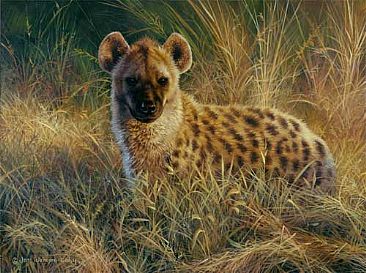 |
| A DRAWING OF A SPOTTED HYENA |
 |
| A STAMP OF A SPOTTED HYENA |
The spotted hyena is a social animal which lives in large communities called "clans", which can consist of up to 80 individuals. Group-size varies geographically; in the Serengeti, where prey is migratory, clans are smaller than those in the Ngorongoro Crater, where prey is sedentary.Spotted hyena clans are more compact and unified than packs, but are not as closely knit as those of African wild dogs.Females dominate males, with even the lowest ranking females being dominant over the highest ranking males. It is typical for females to remain with their natal clan, thus large clans usually contain several matrilines, whereas males typically disperse from their natal clan at the age of 2½ years. The clan is afission-fusion society, in which clan-members do not often remain together, but may forage alone or in small groups.High-ranking hyenas maintain their position through aggression directed against lower-ranking clan-members. Spotted hyena hierarchy is nepotistic; the offspring of dominant females automatically outrank adult females subordinate to their mother.However, rank in spotted hyena cubs is greatly dependent on the presence of the mother; low-ranking adults may act aggressively toward higher-ranking cubs when the mother is absent. Although individual spotted hyenas only care for their own young, and males take no part in raising their young, cubs are able to identify relatives as distantly related as great-aunts. Also, males associate more closely with their own daughters rather than unrelated cubs, and the latter favour their fathers by acting less aggressively toward them.Spotted hyena societies are more complex than those of other carnivorous mammals, and are remarkably similar to those of cercopithecine primates in respect to group size, structure, competition and cooperation. Like cercopithecine primates, spotted hyenas use multiple sensory modalities, recognise individual conspecifics, are conscious that some clan-mates may be more reliable than others, recognise 3rd party kin and rank relationships among clan-mates, and adaptively use this knowledge during social decision making. Also, like cercopithecine primates, dominance ranks in hyena societies are not correlated with size or aggression, but with ally networks. In this latter trait, the spotted hyena further show parallels with primates by acquiring rank through coalitions. However, rank reversals and overthrows in spotted hyena clans are very rare.Territory size is highly variable, ranging from less than 40 km² in the Ngorongoro Crater to over 1,000 km² in the Kalahari. Home ranges are defended through vocal displays, scent marking and boundrary patrols.Clans mark their territories by either pasting or pawing in special latrines located on clan range boundraries. Clan boundraries are usually respected; hyenas chasing prey have been observed to stop dead in their tracks once their prey crosses into another clan's range. Hyenas will however ignore clan boundraries in times of food shortage. Males are more likely to enter another clan's territory than females are, as they are less attached to their natal group and will leave it when in search of a mate. Hyenas travelling in another clan's home range typically exhibit bodily postures associated with fear, particularly when meeting other hyenas. An intruder can be accepted into another clan after a long period of time if it persists in wandering into the clan's territory, dens or kills.
| A SPOTTED HYENA CUB WITH MOTHER |
The spotted hyena is a non-seasonal breeder, though a birth peak does occur during the wet season. Females are polyestrus, with an estrus period lasting two weeks. Like many felid species, the spotted hyena is promiscuous, and no enduring pair bonds are formed. Members of both sexes may copulate with several mates over the course of several years. Males will show submissive behaviour when approaching females in heat, even if the male outweighs its partner.Females usually favour younger males born or joined into the clan after they were born. Older females show a similar preference, with the addition of preferring males with whom they have had long and friendly prior relationships. Passive males tend to have greater success in courting females than aggressive ones.Copulation in spotted hyenas is a relatively short affair, which typically only occurs at night with no other hyenas present. The mating process is complicated, as the female's reproductive tract is entered and exited through her pseudo-penis rather than directly through the vagina, which is blocked by the false scrotum and testes. Once the female retracts her clitoris, the male enters the female by sliding beneath her, an operation facilitated by the penis' upward angle. Once this is accomplished, a normal mating stance is adopted.

No comments:
Post a Comment